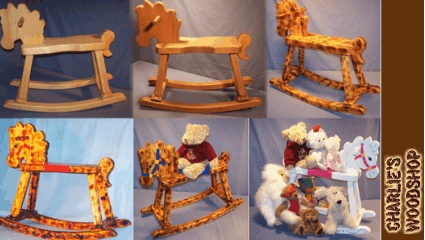One of the products Charlies Woodshop sells is Made in the USA Puzzles. A more complete list of their products is provided by Made in America Secrets, to review their list click here.
For more information about Charlies Woodshop and its Made in America products see the following:
Wooden Building Blocks tend to start out as the child's first building experience, with lots of choices and nobody to tell them they aren't doing it correctly. This makes it more fun and entertaining for the child and even the parents.
The first thing they do is simply stack them one on top of each other, as tall as they can. Then either they fall on their own or the child knocks them over with the biggest smile or laughter. This is exciting to watch and remember for a lifetime.
The second is they start to build something that only their imagination and ingenuity understands. This is the age that we all would like to maybe relive, when we had no cares in the world, and we could do (at least we thought we could) anything we dared.
As they continue to build to the diagrams in their minds, they start to learn relationships about the blocks. This is a size/color relationship where we call them a unit building system and the color is given to a block based on the length of the block.
All of the building blocks in the set have the following parameters.
1. There are either rectangular solids or cylinders.
2. A unit building system is where all blocks in the set have one (1) dimension in common. It is the
thickness of the rectangular solid or the diameter of the cylinder. They all equal the Unit 1
and all the other dimensions are a multiple of the unit thickness.
3. There are varying widths for the rectangular solids 1, 2, 3, or 4 units. This does vary between
blocks, because you can't have a width wider than the length of the block.
4. There are varying lengths, 1, 2, 3, 4, 5, 6, 7, 8, 9, & 10 in both rectangular solids and the
cylinders.
5. The length determines the color.
NOW with these parameters in mind, DO NOT tell the child these facts. They will learn on their own through trial and error. This will be a good learning experience, as when they discover relationships on their own, they will feel a great sense of accomplishment, and self-reward. This also helps build confidence, and self esteem.
As the child continues to build, they learn that if they use a particular color to make a wall (or similar item) by standing all of those particular colored blocks on end, that they are the same height. When they run out, they start to substitute other colors and find none are exactly the same. So they start to combine multiple blocks of different colors or combinations there of to equal the same height of the original color. I hope you see where this is leading.
Once the child learns some of these relationships over and over, they will use the concept they have learned to build more exacting and with much more precision.
Educationally, we have now gotten to where schools and teachers take over. These relationships of the building system are really nothing more than mathematical relationships. Substitution of a number for a color can be a simple process for adding and subtracting.
But our educationally structured Wooden Building Block Systems go much further than simple adding and subtracting. You can multiply and divide equally as well. I will also tell you we can prove Pythagorean's Theorem which is expressed as, C2 = A2 + B2, and taught in plane geometry classes in middle or high school grades. We have taken D and E students and within 20 to 30 minutes the student grasped the concept so well that by not contacting the student for an entire year, then confronting them with the problem of proving Pythagorean's Theorem, they proceed to do so as if it were yesterday that it was explained. Mind you, there is one key ingredient here that I must point out, the student had to want to learn. It can be shown by many good educators that a good teacher is one who has the ability to create an environment where a student wants to learn. This can even be said about a parent who try's to provide for their children the best educational toys they can, to create an environment for them to learn as much as possible.
For more information about Charlies Woodshop and its Made in America products see the following:
Wooden Building Blocks tend to start out as the child's first building experience, with lots of choices and nobody to tell them they aren't doing it correctly. This makes it more fun and entertaining for the child and even the parents.
The first thing they do is simply stack them one on top of each other, as tall as they can. Then either they fall on their own or the child knocks them over with the biggest smile or laughter. This is exciting to watch and remember for a lifetime.
The second is they start to build something that only their imagination and ingenuity understands. This is the age that we all would like to maybe relive, when we had no cares in the world, and we could do (at least we thought we could) anything we dared.
As they continue to build to the diagrams in their minds, they start to learn relationships about the blocks. This is a size/color relationship where we call them a unit building system and the color is given to a block based on the length of the block.
All of the building blocks in the set have the following parameters.
1. There are either rectangular solids or cylinders.
2. A unit building system is where all blocks in the set have one (1) dimension in common. It is the
thickness of the rectangular solid or the diameter of the cylinder. They all equal the Unit 1
and all the other dimensions are a multiple of the unit thickness.
3. There are varying widths for the rectangular solids 1, 2, 3, or 4 units. This does vary between
blocks, because you can't have a width wider than the length of the block.
4. There are varying lengths, 1, 2, 3, 4, 5, 6, 7, 8, 9, & 10 in both rectangular solids and the
cylinders.
5. The length determines the color.
NOW with these parameters in mind, DO NOT tell the child these facts. They will learn on their own through trial and error. This will be a good learning experience, as when they discover relationships on their own, they will feel a great sense of accomplishment, and self-reward. This also helps build confidence, and self esteem.
As the child continues to build, they learn that if they use a particular color to make a wall (or similar item) by standing all of those particular colored blocks on end, that they are the same height. When they run out, they start to substitute other colors and find none are exactly the same. So they start to combine multiple blocks of different colors or combinations there of to equal the same height of the original color. I hope you see where this is leading.
Once the child learns some of these relationships over and over, they will use the concept they have learned to build more exacting and with much more precision.
Educationally, we have now gotten to where schools and teachers take over. These relationships of the building system are really nothing more than mathematical relationships. Substitution of a number for a color can be a simple process for adding and subtracting.
But our educationally structured Wooden Building Block Systems go much further than simple adding and subtracting. You can multiply and divide equally as well. I will also tell you we can prove Pythagorean's Theorem which is expressed as, C2 = A2 + B2, and taught in plane geometry classes in middle or high school grades. We have taken D and E students and within 20 to 30 minutes the student grasped the concept so well that by not contacting the student for an entire year, then confronting them with the problem of proving Pythagorean's Theorem, they proceed to do so as if it were yesterday that it was explained. Mind you, there is one key ingredient here that I must point out, the student had to want to learn. It can be shown by many good educators that a good teacher is one who has the ability to create an environment where a student wants to learn. This can even be said about a parent who try's to provide for their children the best educational toys they can, to create an environment for them to learn as much as possible.

